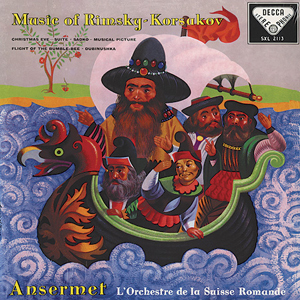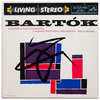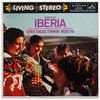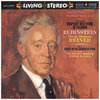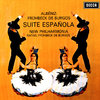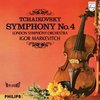Speakers Corner / Decca SXL 21132 - 180 Gram Virgin Vinyl -
AAA 100% Analogue - Limited Edition - Decca ffss SXL 2113
Pure Analogue Audiophile Mastering - Pressed at Pallas Germany
AAA 100% Analogue This LP was Remastered using Pure Analogue Components Only, from the Master Tapes through to the Cutting Head
Rimsky-Korsakov: “Christmas Eve“ (Suite), “Sadko“, “The Flight of the Bumble bee“, “Dubinushka“ – Orchestre de la Suisse Romande conducted by Ernest Ansermet
Rimsky-Korsakov was not only a masterly composer of great operas and eloquently powerful symphonies but a genius when it came to the smaller forms, and ample proof is provided by this delightful compilation on the DECCA label. The fairytale, programmatic music of the Christmas Eve Suite conjures up a fantastic world where the stars and planets dance and play above a snowy landscape until the witches’ sabbath begins and Vakula appears on his satanic warhorse. Brimming over with a wealth of highly varied Slavonic dance rhythms, genial instrumentation, and delightful melodies, this Suite offers nothing but pleasure the whole year through.
The musical picture Sadko tells the story of a seafaring hero who is obliged to entertain Neptune at his court with music. Dancing water-spirits evoke a terrible storm from which Sadko only manages to escape with his life thanks to Saint Nicholas. Further attractions are to be found on the B side, namely the pre-revolutionary march Dubinushka (“The little oak stick”), and of course the immensely popular Flight of the Bumble-Bee which is sheer magic in this full orchestral version. If by now your mouth is watering for a taste of these Russian delicacies, just help yourself!
Further attractions are to be found on the B side, namely the pre-revolutionary march Dubinushka (“The little oak stick”), and of course the immensely popular Flight of the Bumble-Bee which is sheer magic in this full orchestral version. If by now your mouth is watering for a taste of these Russian delicacies, just help yourself!
Although Rimsky-Korsakov was hardly a major composer, he was one of the greatest minor composers. His art is severly limited, yhet within those limits he achieved things that are perfect of their kind, and were unique of their kind when he achieved them, though others have imitated or developed them since. And within a relatively small range, he attained remarkable variety; his operas alone show his mastery of the dramatic, the lyrical, the epic and the fantastic. He was much more than a brilliant orchestrator, though he admittedly delighted in orchestral colour for its own sake and regarded it as a primary and essential element of his music.
Recording: November 1956 at Victoria Hall, Geneva by James Brown
Production: James Walker
Musicians:
Ernest Ansermet, conductor
Ochestre de la Suisse Romande
Selections:
Nikolai Rimsky-Korsakov (1844 - 1908)
1. Christmas Eve Suite
2. Sadko
3. The Flight of the Bumble Bee
4. Dubinushka
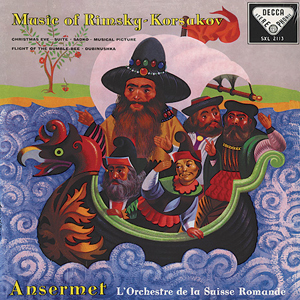
20 Years pure Analogue
Are your records completely analogue?
Yes! This we guarantee!
As a matter of principle, only analogue masters are used, and the necessary cutting delay is also analogue. All our cutting engineers use only Neumann cutting consoles, and these too are analogue. The only exception is where a recording has been made – either partly or entirely – using digital technology, but we do not have such items in our catalogue at the present time
Are your records cut from the original masters?
In our re-releases it is our aim to faithfully reproduce the original intentions of the musicians and recording engineers which, however, could not be realised at the time due to technical limitations. Faithfulness to the original is our top priority, not the interpretation of the original: there is no such thing as a “Speakers Corner Sound”. Naturally, the best results are obtained when the original master is used. Therefore we always try to locate these and use them for cutting. Should this not be possible, – because the original tape is defective or has disappeared, for example – we do accept a first-generation copy. But this remains an absolute exception for us.
Who cuts the records?
In order to obtain the most faithful reproduction of the original, we have the lacquers cut on the spot, by engineers who, on the whole, have been dealing with such tapes for many years. Some are even cut by the very same engineer who cut the original lacquers of the first release. Over the years the following engineers have been and still are working for us: Tony Hawkins, Willem Makkee, Kevin Gray, Maarten de Boer, Scott Hull, and Ray Staff, to name but a few.
At the beginning of the ‘90s, in the early days of audiophile vinyl re-releases, the reissue policy was fairly straightforward. Companies such as DCC Compact Classics, Mobile Fidelity, Classic Records and others, including of course Speakers Corner, all maintained a mutual, unwritten code of ethics: we would manufacture records sourced only from analogue tapes.
Vinyl’s newfound popularity has led many other companies to jump on the bandwagon in the hope of securing a corner of the market. Very often they are not so ethical and use every imaginable source from which to master: CDs, LPs, digital files and even MP3s.
Even some who do use an analogue tape source employ a digital delay line, a misguided ’80s and ‘90s digital technology that replaces the analogue preview head originally used to “tell” the cutter head in advance what was about to happen musically, so it could adjust the groove “pitch” (the distance between the grooves) to make room for wide dynamic swings and large low frequency excursions. Over time analogue preview heads became more rare and thus expensive.
So while the low bit rate (less resolution than a 16 bit CD) digital delay line is less expensive and easier to use than an analogue “preview head”, its use, ironically, results in lacquers cut from the low bit rate digital signal instead of from the analogue source!
Speakers Corner wishes to make clear that it produces lacquers using only original master tapes and an entirely analogue cutting system. New metal stampers used to press records are produced from that lacquer. The only exceptions are when existing metal parts are superior to new ones that might be cut, which includes our release of “Elvis is Back”, which was cut by Stan Ricker or several titles from our Philips Classics series, where were cut in the 1990s using original master tapes by Willem Makkee at the Emil Berliner Studios. In those cases we used only the original “mother” to produce new stampers.
In addition, we admit to having one digital recording in our catalogue: Alan Parsons’ “Eye in the Sky”, which was recorded digitally but mixed to analogue tape that we used to cut lacquers.
In closing, we want to insure our loyal customers that, with but a few exceptions as noted, our releases are “AAA”— analogue tape, an all analogue cutting system, and newly cut lacquers.
PALLAS
Audiophile Vinyl - Made in Germany For over 60 years the family business in the third generation of the special personal service and quality "Made by Pallas" is known worldwide. Our custom PVC formulation produces consistently high pressing quality with the lowest surface noise in the industry. Our PVC complies with 2015 European environmental standards and does not contain toxic materials such as Lead, Cadmium or Toluene. Our vinyl is both audiophile and eco-grade!
